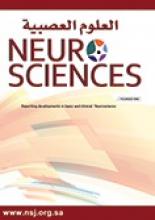Pediatric intracranial hypertension
Experience from 2 Tertiary Centers

Abstract
Objectives: To review the experience of 2 tertiary centers in Saudi Arabia with intracranial hypertension (IH) in the pediatric population.
Methods: We retrospectively reviewed and analyzed pediatric patients diagnosed with IH from June 2002 to May 2017 in 2 institutes.
Results: We identified 53 patients (30 females and 23 males) with a mean age of 7 years at the time of presentation. Among them, 41 patients were younger than 12 years, and 12 were older. Obese and overweight patients constituted 27.00% (n = 14) of all cases, 8 (66.7%) of whom were older than 12 years. The most common presenting feature was papilledema followed by headache. Vitamin D deficiency, which constituted the most common associated condition, was identified in 12 (22.6%) patients. Acetazolamide was the treatment option in 98.11% of patients, and only 5.7% underwent surgical interventions. The length of follow-up ranged from 6 months to 8 years.
Conclusion: Intracranial hypertension is rare in children and commonly seen in overweight females older than 12 years similar to adults. Patients younger than 12 years tend to develop secondary IH. More studies are needed to characterize the clinical presentation and guide the management plan.
Footnotes
Disclosure. Authors have no conflict of interests, and the work was not supported or funded by any drug company.
- Received June 12, 2019.
- Accepted August 13, 2019.
- Copyright: © Neurosciences
Neurosciences is an Open Access journal and articles published are distributed under the terms of the Creative Commons Attribution-NonCommercial License (CC BY-NC). Readers may copy, distribute, and display the work for non-commercial purposes with the proper citation of the original work.
In this issue
Jump to section
Related Articles
- No related articles found.
Cited By...
- No citing articles found.





